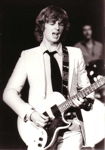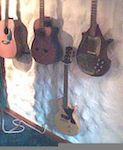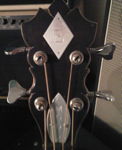Notes
Mike recorded Incantations in his new home, Througham, where he moved to just after the completion of Ommadawn. Mike said in an interview at the time he moved in, that there was space to record a small orchestra in there. It is clear, looking back, that he was then already shaping up the ideas for Incantations, an album which of course included a small orchestra. They were featured prominently as well - small ensembles had been used on both Hergest Ridge (strings and choir) and Ommadawn (brass band) but they had never seemed as important a feature as they are in Incantations, with them only providing chordal 'pad' parts in those earlier albums (although to be fair, these features were always more than just 'background').
Half way through the recording of the album, Mike went through a fairly new and very controversial form of therapy called Exegesis. Information on this varies, but it seems it was something like this...
The course lasted for about three days, and was held in a hotel in London. The main message that the therapy put across to its subjects was that they could blame nothing that happened in their lives on somebody else - they were responsible for everything. The way the message across, however, was rather severe. The subjects were kept in one room for many hours every day. They were not allowed to leave apart from at the end of the session, not even to go to the toilet. People were often lined up in rows, while the course leaders shouted at them (often telling them they were worthless, using many expletives and other such things), or stared hard at them directly in their faces. People who met Mike after he had undertaken the therapy often found that he'd stare at them in exactly the same way, with his face only a few inches from theirs. The part which perhaps left the biggest impression on Mike was where he went through a rebirth experience. The course goers were encouraged to visualise their worst fears and problems, then confront them. Through this, it emerged that Mike's problems all stemmed from him having a distressing birth. He then went through this rebirth experience to counteract this. People who went through this course of therapy were sometimes known to display odd, extreme behaviour. Whether this was true of Mike or not doesn't seem certain to me...I'm sure Mike would tell you it's not true at all. Certainly he seemed to become much more assertive, with some people claiming he was almost too assertive...
The single 'Guilty' which was released shortly after Incantations, and uses themes from the album, seems to reflect the philosophy of responsibility that Exegesis professed - the idea that Mike was guilty of causing his problems, rather than anyone else.
Mike finished the rest of Incantations after having undertaken Exegesis. People have sometimes pointed out differences in style between the parts he recorded before and the parts he recorded afterwards. Certainly Mike said after recording Incantations that he was only really happy with the new sections.
As part of his new found assertiveness, Mike did something that some people would never have expected happening - he took Incantations on tour. Recordings from that tour would later surface as 'Exposed'...
Incantations was released as a double LP and at just over 72 minutes was, until Light + Shade in 2005, the longest album Mike had ever released.
The sleeve design was credited to Trevor Key, but Mike mentions, in his autobiography Changeling, how the cover photograph was taken by a friend of Richard Branson's, Carlos Moyse (p209).
Personnel
| ▸ | David Bedford (conductor) | | Classically trained composer, and fellow member of Kevin Ayers's band 'The Whole World', with whom Mike played bass and guitar (David played mostly keyboards). By the end of 1974, David had arranged both Tubular Bells and Hergest Ridge for orchestra. Both pieces were premiered at the Royal Albert Hall in London, with Steve Hillage, from the group Gong, on guitar. Mike was scheduled to play, but was unable to due to 'illness' (the illness was more mental than physical - Mike couldn't cope with appearing in public). The Orchestral TB was later released as an album, with Mike Oldfield on guitar. A recording of a performance of the Orchestral HR in Scotland (also with Steve Hillage - most performances were him, although Andy Summers of the Police did a few in the North of England), made by the BBC, was bought by Virgin, although it was never released.
Bedford also taught at Queen's College, members whose choir were to appear later on Incantations and Exposed. He recorded many albums of his own, often experimental music, some of which Mike played on. Also appears in: The Orchestral Tubular Bells, Hergest Ridge, Exposed, QE2, The Killing Fields
| | ▸ | Jabula (ensemble) | | Meaning 'Happiness' in Zulu, Jabula was an afro jazz band formed in 1974 by musicians who'd left apartheid-era South Africa and settled in London. They signed to Virgin to make their eponymous debut album, released in 1975, and it was Virgin's Simon Draper who introduced them to Mike. Also appears in: Ommadawn
| | ▸ | The Queen's College Girls Choir (ensemble) | | David Bedford taught and led the choir at Queen's College. David also used the choir on his own recordings, including on one where he got them to inhale helium (the lighter-than-air gas used sometimes used to inflate balloons, which also has the effect of making the vocal cords contract) so they could hit ridiculously high notes. Also appears in: Exposed
| | ▸ | Sebastian Bell (musician) | | Also played on David Bedford's "Nurses Song with Elephants"
| | ▸ | Mike Laird (musician) | |
| | ▸ | Pierre Moerlen (musician) | | Drummer with (and later leader of) the prog-rock group Gong. Mike would have met Gong while he was at The Manor recording Tubular Bells at the same time as they were recording their 'Flying Teapot' album (another of Virgin records' early releases). Mike made a guest appearance on Gong's LP 'Downwind'. He died unepectdly of natural causes in 2005. Also appears in: Ommadawn, Exposed, Platinum, Islands
|
| | ▸ | Sally Oldfield (musician) | | Mike's older sister, who formed a duo named Sallyangie with him when he was 15. She went on to have a successful career as a solo artist. Also appears in: Tubular Bells, Tres Lunas, Tubular Bells 2003
| | ▸ | Terry Oldfield (musician) | | Mike Oldfield's older brother, who had only just begun playing the flute when he was drafted in to play in the premiere concert for Tubular Bells in 1973. He has since gone on to become a well known producer of new age music, often featuring his woodwind playing. Also appears in: Hergest Ridge
| | ▸ | Maddy Prior (musician) | | Singer with British folk-rock group Steeleye Span. Also appears in: Exposed
| | ▸ | Trevor Key (cover artwork) | | Also appears in: Tubular Bells, Hergest Ridge, Platinum, Tubular Bells 2003
| | ▸ | Carlos Moyse (cover artwork) | | Mike says in Changeling that Carlos was a friend of Richard Branson's, who later switched from being a photographer to a promoter. According to Mike, Carlos's family had a house on the beach where the Incantations cover photo was taken.
|
|
Instruments
| Headphones |
| Koss Pro 4AA headphones |
Mike can be seen wearing these in the making of Blue Peter feature, as well as pictures of him in Througham. |
|
| Miscellaneous stringed instruments |
| Harp |
|
Also used in Ommadawn
|
| Percussion instruments |
| Bodhrán |
18" bodhrán decorated with a St John Eagle from the Book of Kells. The bodhrán (pronounced as bough-rahn or bow-rahn) is an Irish frame drum made from goatskin, played with a beater called a tipper or cípín. A bodhrán was also used on Return To Ommadawn in 2016. |
Also used in Ommadawn, Five Miles Out, Amarok, Voyager, Return To Ommadawn
|
| Paiste Symphonic Gong |
|
Also used in Ommadawn
|
| Marimba |
|
Also used in Ommadawn
|
| Musser Vibraphone |
Shown in pictures of Mike with David Bedford at Througham in 1976. |
|
| Electric guitars |
| Gibson L6-S Deluxe |
Mike had this guitar modified by Tony Zemaitis sometime between 1979 and 1980. He added an engraved metal scratchplate and headstock plate.
 
 |
This appears to have been Mike's favourite of the two L6-Ss, and likely the one used on Incantations, with the wine red L6-S Custom being acquired as a spare for touring.
Also used in Exposed, Platinum
|
| 1957 Gibson Les Paul TV model |
s/n 7 2031. This guitar was modified with a 2 octave fretboard. It was bought by a Scottish fan.
    
 |
Mike told Guitar Player that this was his main instrument and that he used it the most.
Also used in Ommadawn, Five Miles Out, Discovery, Amarok
|
| Bass guitars |
| 1960 Fender Precision Bass, blonde |
s/n 48986. Mike bought this shortly after recording Tubular Bells. He played it on the BBC Second House performance in 1974. The frets were later removed from it. Sold via Chandler Guitars in February 2006.
    
 |
Also used in Hergest Ridge, Ommadawn, QE2, Five Miles Out
|
| 1975 Zemaitis acoustic bass guitar |
Sold via Chandler Guitars in February 2008
    
 |
Also used in Ommadawn, Five Miles Out
|
| Amps |
| Fender Twin Reverb |
|
Also used in Ommadawn, Exposed, Discovery, Tubular Bells 2003, Return To Ommadawn
|
| Vox Escort |
Battery powered guitar amplifier, used as part of the signal chain for Mike's mid 70s distorted guitar sound. Can be seen in the William Tell Overture video. |
|
| Pianos |
| Bösendorfer grand piano |
This piano is shown in pictures of Mike in his Througham studio, so it's likely he used it on the recordings he made there. |
|
| Organs |
| Farfisa Professional Organ |
Return To Ommadawn used a Farfisa sotware emulation.

 |
Also used in Tubular Bells, Hergest Ridge, Ommadawn, Crises, Amarok, Tubular Bells II, Tubular Bells 2003, Return To Ommadawn
|
| Synthesisers |
| ARP 2600 |
Semi-modular analogue monophonic synthesiser. |
Also used in Ommadawn
|
| Solina string ensemble |
String synthesiser produced by the Dutch organ company Eminent and later rebadged by ARP. It owed much of its sound to its ensemble effect, created by running the sound through three LFO-modulated delay lines. |
Also used in Ommadawn, Platinum, QE2, Five Miles Out, Crises, Return To Ommadawn
|
| Roland SH-2000 |
Monophonic analogue synthesiser. Mike often used the clarinet preset, recording it at half speed to create the recorder-like whistling sound which was a common feature of his albums and singles between 1978 and 1980. |
Also used in Platinum
|
| Microphones |
| Neumann KM86 |
Used for recording acoustic guitars and many other instruments, from the Incantations era onwards. |
Also used in QE2
|
| Neumann U87 |
Large diaphragm condenser microphone with selectable polar patterns. |
A pair of them can be seen above a marimba in a picture of Mike at Througham
Also used in Ommadawn, Return To Ommadawn
|
| Loudspeakers |
| Westlake TM-1 |
|
Mike's studio at Througham had four of these, to allow him to mix in quad.
Also used in Ommadawn, Platinum
|
| Studio effects and outboard |
| Allison Research Kepex |
Limiter, used in the 1970s (and possibly beyond) as part of Mike's guitar recording chain. |
|
| EMT 250 |
Digital reverb. |
Speaking to Guitar Player magazine in 1978, Mike said he also had a quadraphonic plate reverb, but liked the EMT250 better. |
| Urei 1176 Peak Limiter |
Mike originally borrowed some of these from the Manor Mobile, but later acquired his own. |
Also used in Ommadawn, Platinum, Tubular Bells II, Tubular Bells 2003
|
| Tape recorders |
| TEAC A3300 |
1/4" stereo tape recorder. For much of the 1970s, its input stage was used as part of the signal chain for Mike's distorted guitar sound. |
Also used in Ommadawn
|
| Ampex MM1200 |
24 track, 2" multitrack tape recorder. As seen in the making of Blue Peter feature. |
Also used in Platinum
|
| Mixing desks |
| Rebis Mixer |
According to Mike in Changeling, this was the first mixer built by Rebis, custom ordered by him for his Througham studio. It was designed as a quadraphonic desk, with quad panpots. After Mike had stopped using it in the studio, he had it put into flight cases and used it on his tours, as well as in many of his temporary studios. |
Also used in QE2, Discovery
|
| Sequencers |
| EMS Universal Sequencer |
Related to the sequencer from EMS's Synthi KS (available both on its own and as part of the Synthi AKS suitcase synthesiser/sequencer, as used by Pink Floyd and Jean Michel Jarre, amongst others). The Universal Sequencer had control voltage and gate outputs for controlling analogue synthesisers. Mike primarily used it together with his ARP 2600. According to EMS, very few of them were made. |
[?]
Also used in Platinum, QE2, Five Miles Out
|
|

